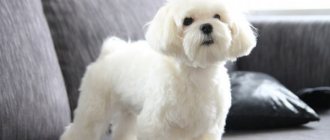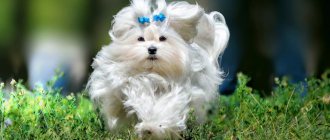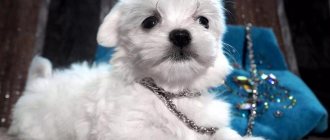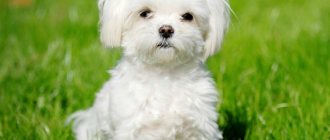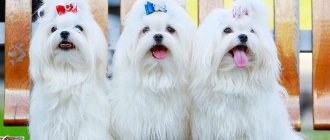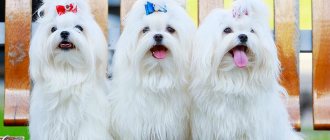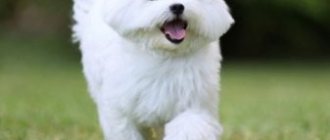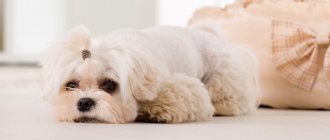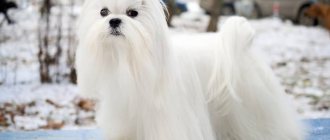This breed of miniature dog is famous for its silky white coat. Straight hair falls all the way to the floor. Many years ago, Maltese dogs came in a variety of colors, but these days they are always white. When a properly built Maltese moves, it is as if he is floating on a white cloud. Because it has no undercoat, the Maltese sheds little and many people consider the breed to be hypoallergenic.
The Maltese has a slightly rounded skull, black nose, floppy ears, dark, alert eyes, short straight legs and a graceful tail. This is a sweet, intelligent dog, devoted to its owner. And as one of the smallest toy breeds, he is well suited to apartment living. Despite the fact that the Maltese looks elegant and aristocratic, they have a lot of energy. They learn quickly, especially if their efforts are rewarded with something tasty. Maltese dogs have a long history as companion dogs, so they require a lot of human attention and suffer from separation anxiety. If left alone, they can bark and become destructive.
No breed is perfect, and Maltese are sometimes intolerant of small children or other animals, especially if they have been spoiled too much. They show signs of jealousy - they will bark and even bite if animals or people are perceived as a threat to their relationship with the owner.
However, even tolerant Maltese dogs are not the best choice for families with small children because they are so small and easily injured.
Standard and description of the Maltese breed
Height at withers: males 21-25 cm, females 20-23 cm; Weight: 3-4 kg.
- Color: solid, snow-white or pale ivory;
- Eye color: dark ocher;
- Nose color: black;
- General appearance: a small dog with straight and long hair, free and fast movements.
Disqualifying signs:
- aggressiveness;
- cowardice;
- wavy coat;
- spotting;
- eyelids without pigment;
- short tail;
- thorn;
- nose that is not black or completely dyed;
- undershot;
- any color other than the permitted one;
- physical abnormalities.
In the ICF Maltese standard dated January 1, 2016, there is no division by size . Miniature Maltese dogs are not officially recognized. However, there are advertisements everywhere with offers for their sale. Perhaps this is the name of the American version of the breed, whose representatives are distinguished by their small size and delicate body constitution. The second option is not uncommon for small dogs. Sometimes mini puppies are born in a litter of standard puppies.
How to choose a pet
The Maltese is a popular breed that scammers often want to make money from selling. To avoid getting a sick or purebred dog as a pet, you need to contact professional breeders or registered kennels.
When choosing a Maltese puppy, it is advisable to look at several litters and ask in advance:
- presence of documents and stamps;
- health status;
- conditions of keeping the mother and puppies.
Pedigree Maltese puppies must have:
- dark eyes;
- black nose;
- white color;
- straight, not too fluffy coat.
On a note. Maltese puppies have a slightly wavy coat that will straighten out as they mature. But strong curls are considered a defect and are unlikely to disappear with age.
Before making the final choice, you need to observe the behavior of the Maltese puppy you like. He should be moderately curious, friendly and sociable.
History of the Maltese
Many believe that the answer to the question of where the first Maltese dogs appeared lies on the surface. This is a misconception, because even experts cannot agree on a common opinion.
The name Maltese comes from the word "malat" . It was often used to refer to islands and localities in the Mediterranean. One version speaks of the Mediterranean, or more precisely of the island of Meleda. Another assumption leads to the city of Melita, which belongs to Sicily.
Historical excavations have suggested that small white dogs with a personality similar to the Maltese lived in Ancient Egypt . In one pharaoh's tomb, archaeologists found a toy in the shape of a Maltese. There are references to them in the annals of the Egyptian people.
The ancient Greeks of that time kept companion dogs similar to lapdogs. Probably due to crossings with foreigners, the Maltese settled in the European part of the continent.
The British noticed the Maltese dogs and appreciated their beauty, intelligence and character. Sailors and traders brought the Maltese to their homes and started breeding. The ancient breed reached its peak of popularity among the nobility of England during the Renaissance. Back then, Maltese dogs were kept by queens and wealthy people.
Thanks to the efforts of English breeders, the breed moved to a new stage of development. Toy poodles and small cocker spaniels participated in the breeding. The work bore fruit in 1864, when the first dogs were presented at an exhibition in Birmingham. After a successful performance, the Maltese was recognized as a breed. In 1873, cynologists in England founded the Maltese Club, although patronage was assigned to Italy.
Maltese dogs arrived in the Russian Empire no earlier than 1812. The highest military ranks of the French army took their snow-white pets with them. Failures forced them to leave the dogs at the sites of destruction. Soon the French dogs found new homes, but lost their breed due to crossings with other dogs.
In the 20th century, the Maltese was not forgotten. This numerous breed is recognized by cynological organizations in Europe and America. Thousands of fans continue to work on improving the Maltese breed.
Puppies
Before getting a lapdog, you should understand that such a dog requires careful care (primarily the fur), as well as long walks. Therefore, the owner will have to find time for his pet. And if this dog is planned to participate in exhibitions, then you will have to visit a hairdresser, train the pet, and carefully care for the fur.
Choosing a puppy
It is better to choose and buy a puppy in a specialized nursery or from trusted breeders. In this case, the buyer is guaranteed to receive a healthy puppy with a pedigree and a certificate of vaccinations from a veterinarian, as well as a veterinary passport, and the dog is equipped with a special microchip.
Price
The price directly depends on the purpose for which the lapdog is purchased. If a puppy is needed only for home keeping, then it can be selected from discarded specimens. In this case, the price of such a puppy will be up to 18 thousand rubles.
Offspring with a pedigree and other documents can cost 60-80 thousand rubles.
Names for boys and girls
Boys of this breed can be called:
- Austin;
- Monty;
- Vander;
- Cake;
- Roland.
The following nicknames are suitable for girls:
- Shawls;
- Lucy;
- Blondie;
- Emmy;
- Julie.
Temperament and character
Despite their sophistication and light weight, Maltese dogs are able to accompany their owner in various situations, gain new knowledge and discover the world.
Positive qualities of the Maltese:
- Mobility;
- Tenderness;
- Intelligence;
- Devotion;
- Playfulness.
Negative qualities:
- Vulnerability;
- They don't like loneliness.
Mating
Maltese dogs mature and grow physiologically quickly. The first heat in bitches occurs at 6–7 months, less often at 10–12 months.
However, Maltese dogs are untied no earlier than 15 months, or on the third heat. The latter are repeated every six months. But you can’t “force” a dog to get pregnant so often. According to generally accepted rules, the next mating is carried out on the second heat after birth.
Childbirth in Maltese dogs is usually trouble-free. A doctor's intervention is not needed, but the owner's help is required: he accepts the puppies and monitors the condition of the bitch. She gives birth to 2 to 5 puppies.
Dog and man
Maltese are sensitive dogs , they can play for hours, and when a person gets tired, they slow down and adapt to the owner. This character trait and comfort in living together defines a companion dog.
The Maltese dog is suitable for an elderly couple, a responsible teenager and lovers of beauty. The only caveat is difficult grooming . If a person has two to three free hours a week to wash and thoroughly comb their pet, then the Maltese is the best option.
For this breed, the preferred living conditions are an apartment or a private house. They will not survive on the street for two reasons: they will freeze, and they will suffer from lack of attention. In addition, a good-natured disposition does not allow one to respond to offenders as they deserve.
The Maltese dog will not cause damage to things and repairs in the apartment. These proud animals are meant for humans and live up to expectations. They are loyal to children and other animals, but may be jealous of new family members and pets.
Interesting Facts
Over the centuries-old history of Maltese dogs, a lot of interesting things have happened to them:
- According to one version, the name of the breed comes not from the name of the Mediterranean island, but from the Latin word malat - “harbour”. This assumption arose due to the fact that Maltese originally traveled with sailors and were a threat to ship rats.
- There is a possibility that Maltese dogs took part in the formation of the Pekingese.
- Dogs of this breed have been the muses of many famous artists. Images of the Maltese are found in paintings by Rubens and Goya.
- Maltese dogs were the favorites of many crowned heads. Tiny snow-white dogs lived at the court of the French king Louis IX, the Spanish ruler Philip II, the English Queen Elizabeth I and Empress Catherine II.
Maintenance and care
Walks
In winter, Maltese dogs get cold because they have no undercoat. Long hair does not protect from the summer heat. In hot weather, such pets are often given bath treatments and provided with coolness and shade.
Contrary to popular belief, Maltese dogs love to walk and need daily walks just as much as their larger counterparts.
You can train a dog of this breed to make do with a diaper or litter box, but fresh air is necessary for the pet’s well-being. Half an hour walks twice a day are enough.
The Maltese is dressed in overalls and boots in winter. Shoes protect the delicate skin of the paws from reagents and cuts from ice. For exhibition specimens with long hair, such precautions are mandatory.
Feeding
An approximate diet for a puppy consists of the following products:
- Boiled or raw meat (beef, turkey, chicken);
- Vegetables;
- Dairy products;
- Fruits .
The puppy is gradually accustomed to such food. The first feeding of the Maltese dog with natural food is at 2-3 weeks. The first to taste is a tiny piece of meat, then cottage cheese with kefir. A one-month-old puppy is fed 5-6 times a day. From 2 months they switch to 4 meals a day. By 6-7 months the dog is fed 2 times a day.
Food ratio for an adult Maltese :
- Meat – 50%;
- Fruits – 25%;
- Vegetables – 25%.
There are rules for feeding dogs with white fur. To maintain purity of color, foods that change shades . These include:
- Sea kale;
- Carrot;
- Liver.
In most cases, dogs stain their fur with food, but seaweed enhances the red color. If the lap dog has an ivory color, it may become stronger with frequent use.
Chicken, red fruits and vegetables are strong allergens , and Maltese are susceptible to them. After introducing a new product to food, it is worth conducting an experiment and observing the pet’s reaction. The first sign of an allergy is watery eyes, itching and irritation on the skin.
Special ready-made food is selected for Maltese dogs. They should be easily digestible, improve the condition of the coat and be hypoallergenic . Breeders recommend including fish oil, vitamins and minerals for the coat in the natural diet.
Grooming and grooming
Many people get Maltese dogs because of their unearthly beauty. Wool is an indicator of health and grooming. Washing Maltese dogs takes a lot of time. To care for the coat you will need:
- Shampoo for white dogs;
- A mask that does not weigh down the hair structure;
- Balm that adds light shine and silkiness;
- Leave-in products with a smoothing effect;
- Conditioner for daily combing and moisturizing;
- Powder or other whitening agent.
Tools:
- Sharp scissors for grooming;
- Wide-toothed comb;
- Massage brush;
- Hairdryer or compressor.
The products are applied in the specified order. Lather the shampoo twice. Wash your Maltese once every 10 days . For an exhibition copy, the period is reduced to 7 days. Comb with moisturizing conditioner - daily . Use a wide-toothed comb to carefully separate the fur and go through it, without pressing or tugging. A massage brush is needed at the final stage. The powder is applied after the wool is dried and styled.
For exhibitions, the snow-white coat of Maltese dogs is grown long enough to reach the ground. Dry in the direction of growth, the cover should be uniform, without partings or shreds.
During the period between exhibitions, the wool is wound onto curling irons . They do this with dogs 7-8 months from birth. Papillots are made from tissue paper. Individual curls are laid on them in layers and secured with an elastic band. Before the procedure, the coat is moisturized with oils or sprays that are suitable for the dog. Re-twist 1-3 times a week. Maltese with thick hair that is not prone to tangling can do without hair curlers. Between procedures, the dog is washed and dried.
Grooming an exhibition specimen requires the hand of a master. In this case, the length is left to the maximum, trimming only the ends. They also cut the hair in the groin of male dogs, under the tail and shape the paws. Seasonal pet haircuts are suitable for pets. The new look of the pet depends on the imagination of the owner and groomer.
Puppies are accustomed to all of the above procedures from 3-4 weeks . By treating your Maltese affectionately, you can achieve complete mutual understanding and enjoy washing and grooming.
Interesting fact: the Maltese's hair grows quickly, like human hair, so it will need to be cut frequently.
Yellow smudges appear around the Maltese's eyes . These tear ducts are removed with a special product. After moistening a cotton pad in it, carefully apply it to the fur and remove stains with light movements. To prevent your eyes from running, it is advisable to review your dog’s diet and visit a veterinarian. Overgrown claws are trimmed with special tweezers. A Maltese dog's teeth are cleaned in a clinic.
Feeding
It is permissible to feed lapdogs both industrial food (not lower than premium) and natural food. In the second case, vitamin complexes will be needed so that the dog receives everything it needs for health.
Bolonki are gluttons and beggars. You should not follow a lead and feed your pet excessively or with food from the table. Obesity and allergies are faithful companions of the breed.
“Souring” of the eyes and excessive lacrimation are the first signal of flaws in the diet. With proper care, your pet will be with you from 12 to 17 years.
Education and training
The Maltese takes 59th place on psychologist Stanley Coren's list. Next to her are a Brussels Griffon, an Italian Greyhound and a French Bulldog. They are in the group of dogs whose learning abilities are below average . During research for them, the command was repeated from 40 to 80 times, and they achieved execution in 30% of cases and above.
The Maltese is taught simple commands that are necessary in everyday life. The companion must be obedient, so it is better not to spoil small dogs. You cannot use physical methods in training, scare or harshly punish your pet.
The Maltese easily recognizes intonations and emotions. You can take this into account and teach your dog to respond to quiet voices and gestures. With such a lapdog, a walk will be a pleasure.
If you are training your Maltese to eat treats, it is best to do the training before feeding. The breed does not have an increased appetite; because of this, treats are carefully selected to interest the dog.
Health
Maltese are generally healthy, but like all breeds they are susceptible to certain diseases.
- Patella luxation in dogs (patella) : This is when the knee joint (often the hind leg) becomes dislodged, causing pain.
- Portosystemic liver shunt: This liver disease occurs when an abnormal vessel causes blood to bypass the liver and therefore not be cleared.
- Progressive retinal atrophy (PRA): a degenerative eye disease. PRA blindness is a slow process that results from the loss of photoreceptors in the back of the eye.
- Hypoglycemia: This condition is caused by low blood sugar levels. Some of the signs may include weakness, confusion, unsteady gait and seizures.
- White Dog Shaker Syndrome: This is a condition that primarily affects white dogs. Signs of this condition include tremors throughout the body, poor coordination, and rapid eye movements. Symptoms usually appear when the dog is between six months and three years old and is stressed or overly excited.
- Tracheal Collapse: Some dogs are prone to this condition in which the trachea, which carries air into the lungs, tends to collapse. The most common sign of tracheal collapse is a chronic, dry, harsh cough, which many describe as sounding like a "goose whistle."
- Reverse sneezing: Sometimes confused with tracheal collapse, this is a much less serious condition that lasts only a few minutes. Reverse sneezing usually occurs when your dog is excited or tries to eat or drink too quickly. It can also happen when there is pollen or other irritants in the air. Discharge from the dog's nose falls onto the soft palate, causing it to automatically close over the trachea. Lightly stroke his throat to help him relax.
Breed photo
A selection of photos of Maltese dogs.
Owner reviews
Owners of lap dogs usually leave positive reviews about their pets, some of which should be cited:
Dve4 (Russia, Moscow):
We purchased this charming creature for our child. And with his appearance in our house there was one more smart creature. The adorable puppy turned out to be not only cute and charming, but also very smart. I quickly got used to the place and immediately understood where I needed to do my business. There are no problems with food either - he eats dry food just fine.
Rekales (Russia):
We bought the puppy quite a long time ago; he was smart, obedient and funny – he charmed our whole family at once. We looked after him according to all the rules, fed him as expected, maybe that’s why he lived with us for 17 years. Everyone was very sad after he passed away.
Bichon Frize
The breed appeared a long time ago, in the 13-14th century on the Canary Islands. The animals were not specially bred. The sailors found small white curly dogs in the tropical forests and decided to bring them to the mainland. During the voyage, the Bichons showed hunting qualities: they boldly hunted rats and mice in the holds, and protected provisions. Therefore, the sailors kept some of the individuals for themselves, and sold others to Europeans.
Canary Bichons found their way to Spain, Italy, England and France. Each country improved dogs in its own way. The Bichon Frize is a French breed that is loved not only by aristocrats, but also by street performers. Dogs can be found on circus posters or paintings from the 15th to 18th centuries.
Curly light coat is a natural necessity. This cover repels the sun's rays and does not accumulate heat. This was the inspiration for the name of the breed: frize from French - curly.
Despite the fact that dogs are considered decorative, they are much denser, larger and heavier than “sofa” pets. Bichons are larger than Chihuahuas or Toy terriers and can grow up to 30 cm and weigh more than 5 kg. In addition, springy curly hair (up to 10 cm, corkscrew curls) adds volume. The only acceptable color is white; red spots are typical only for puppies.
Active, positive, cheerful dog. An ideal family pet that values and loves all members of the household equally. Bichons are kind, flexible, and get along with children. They like games and sports.
Thanks to their mental abilities and physical fitness, Lapdogs can cope with any task. They show good results in agility, circus work, and freestyle. The main drawback of the breed is playfulness. Bichon Frizes love to chew and break everything. The cost of puppies is up to 50,000 rubles.
